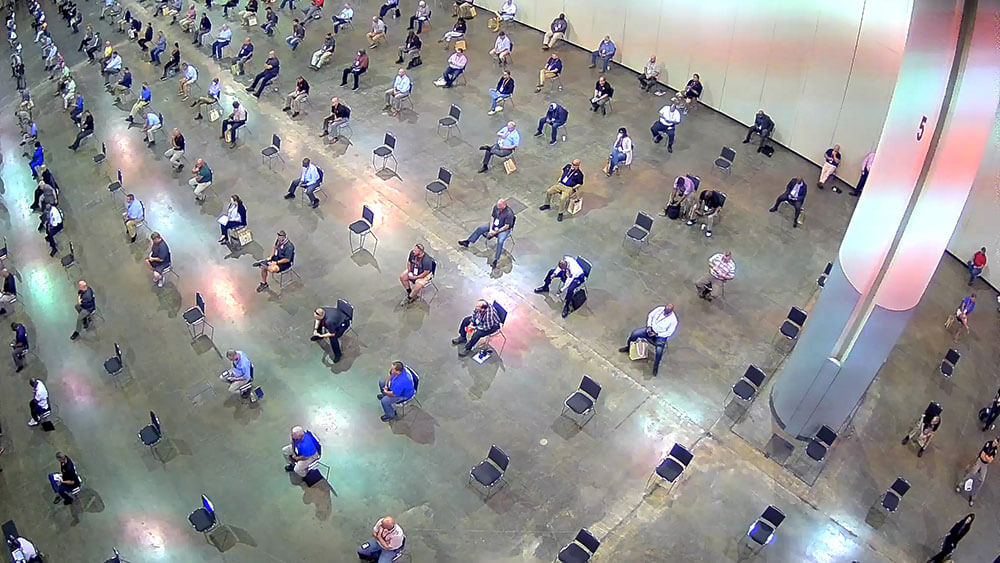
The Georgia Association of Chiefs of Police meet for the 2020 Summer Training Conference at the Savannah Convention Center. Some live events, with strict safety protocols, are returning, but the COVID-19 crisis will continue to affect the business events industry.
When the lockdowns began in the U.S. in March, we hoped we’d have COVID-19 well under control by the fall. In other words, by now. But, as we enter the last quarter of 2020, we’ve come to accept that we will be living with COVID-19 well into 2021 and perhaps 2022 — and that its effects on the economy will linger, certain consumer and workplace behaviors have changed for good, and that the business events industry will look markedly different from now on.
These sentiments were reflected in the responses of more than 800 business events professionals — 558 planners and 231 suppliers — who participated in the latest COVID-19 Recovery Dashboard survey, conducted Sept. 21-24. One planner said as much in describing the scenario he or she thought best illustrated the business events recovery:
“I guess I feel that this is with us from here on out — meaning that once a vaccine is developed, we’ll still have to contend with people being vaccinated and society reaching herd immunity. So, people may be slow to come back to large group gatherings because they may still not feel safe. Also, virtual meetings have now demonstrated that we can obtain access to content without needing to travel. For those who didn’t like to travel/had time restrictions around traveling, they’re going to expect a virtual component. Also, some audiences’ budgets have been frozen. When will that end? We may see reduced in-person attendance because of lack of funding for travel on the part of attendees. For some of us, I think we’re going to have to [reimagine] our meeting model — that could mean moving to all-virtual, having smaller in-person gatherings with larger online presences, smaller meetings we hold on a regional basis, etc. I think it will depend on the association and what their constituents demand.”
A reckoning with COVID-19’s long-term effects on the business events industry is evident in how some of the responses in this survey compare with those of just a month ago — particularly in terms of revenue losses. A significantly greater percent of both planners and suppliers expect losses in the 50- to 75-percent range in 2021 compared to responses in August.
Meanwhile, some responses this month may indicate a greater willingness to participate in and conduct live events in the current environment.
For example, in this month’s survey, we asked two new questions: Have you attended a face-to-face event in the last few months requiring the use of PPE and other safety protocols? And if so, how would you describe your experience?
While only a minority — 17 percent of planners and 31 percent of suppliers — said they had attended an in-person event recently, the majority indicated that they were not put off by all the measures necessary to meet safely today: Sixty-five percent of planners and 74 percent of suppliers said they would do it again. Thirty-one percent of planners and nearly one-quarter of suppliers gave the experience an “okay” rating and said they didn’t think it was a viable option for most groups. Only 5 percent of planners and 2 percent of suppliers said they didn’t find it enjoyable and wouldn’t do it again.
The responses to one question in particular this month revealed changing sentiments about live events — both pro and con. Once again, we asked how far respondents would be willing to travel to attend an in-person event in the absence of therapeutic treatment or a vaccine for COVID-19. Thirteen percent of planners, compared to just 3 percent in the August survey, and 18 percent of supplier respondents — double that of last month’s survey — said they would be willing to take a two-hour flight, which we may attribute to a greater awareness of airline carriers’ stringent safety measures. But on the other end of the spectrum, this month, a slightly higher percentage of planner and supplier respondents, 44 percent and 30 percent, respectively, said they would not travel in the absence of a COVID-19 vaccine.
Industry practitioners’ appetite to travel is one thing, but the crux of the matter is how willing are their attendees? In the words of one planner respondent, “We can consider all the safety protocols we want but it’s up to attendees and when they feel ready to return. And that is hard to plan for.”
Please download a PDF of the full September Recovery Dashboard results by clicking the link below.
Previous Recovery Dashboard Results
Find all the past results on our Recovery Dashboard archive page.
